My shopping cart
Your cart is currently empty.
Continue Shopping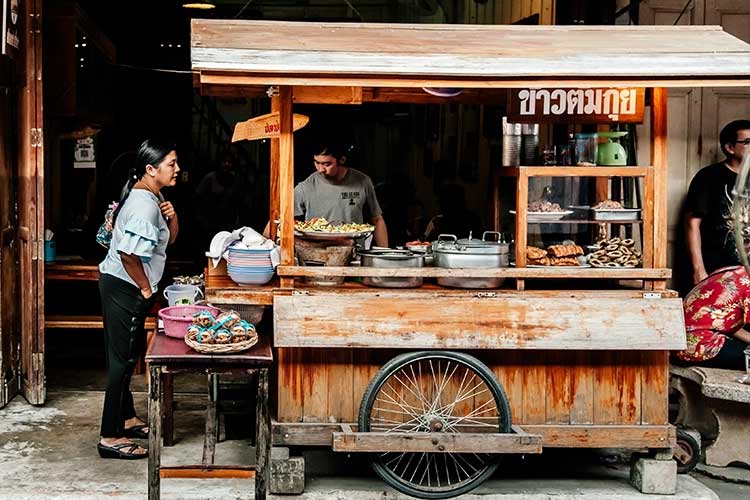
Thai food is famous around the world, but surprisingly, the method of eating some of well-known dishes like curry, Som Tam or Tom Yam Soup is still a myth to many.
Most Thai restaurants in foreign countries might serve those dishes with the utensils or customize them in a way that their customers are familiar with, rather than what you would see in restaurants in Thailand.
There are no strict rules for eating Thai food, but for visitors who want the genuine Thai dining experience, here are some guidelines for how you can eat Thai food like local Thais.

When eating in a group, especially at dinner time, Thai people like to order a variety of dishes to share.
Unlike western meals where dishes are served in courses, a Thai meal is served all at once, allowing diners to enjoy complementary combinations of different tastes. Each person will be served an individual plate of rice. Each of the shared dishes should have a separate serving spoon, and you will get a separate set of small bowls and a soup spoon for eating soup and curry.
Thai food is typically enjoyed with a spoon and fork. The spoon is the main utensil, and a fork is used to arrange a proper amount of food onto the spoon before putting it to your mouth. If you use a fork to scoop rice, it will fall off. Scoop food from the shared dishes on top of your rice and scoop it up with a spoon for a bite. Chopsticks are for noodles and Chinese or Japanese food.
You can read more about Table manners and dinner etiquette in Thailand here.

Thai people like to season their food and spice things up to match their own taste, and it is a common thing to do in Thailand (but this doesn’t apply if you dine at fine dining or upscale restaurants).
The table of local restaurants, especially noodle shops, generally provides some condiments, most are sugar, dried chili flakes, fish sauce and white vinegar (sometime with chilies).
This allows you to adjust the food to individual taste preferences, but do not forget to taste the food before adding the condiments.
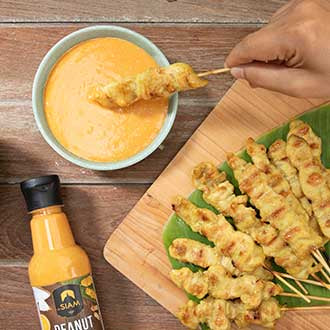
Fish sauce with fresh chilies, or Phrik Nam Pla, is the most popular condiment served with food. If you find your dish too bland, add a few drops of spicy fish sauce onto the dish.
Some restaurants may serve more than one dipping sauces with seafood dishes, dim sum or grilled meats. You can taste each of them and choose the flavor that you like or matches with the food. It is up to you to eat only one of them, all of them or just skip it.
The way Thai people use a dipping sauce is by adding a few drops on top of the food or meat. Or if it is served in an individual bowl, you can dip the meat directly into the dips.

Much of Thai cuisine, like noodles, curries, salad or spicy dips, is typically served with a side dish full of fresh or pickled vegetables.
You can eat them with that dish or leave it as it is. If it is served with noodles, you can just add them on top of the food.
The vegetables served with a salad dish are used to cool down the spiciness, so you can eat them separately or after a bite of spicy food. Spicy chili dips, or Nam Phrik, is eaten by taking the vegetable onto your plate, putting some dips on top and eating it.

Noodle soup is generally served in an individual bowl. Thais usually start by tasting and seasoning the noodles to their liking by adding chili flakes, sugar, fish sauce, or vinegar.
When eating noodle soup, Thais use chopsticks and a soup spoon. Chopsticks will be held in the dominant hand, and a spoon in the other. Grab a small amount of noodles and pull them out of the soup, then eat directly from the chopsticks or place them in the spoon before eating.
You can add a small amount of noodles, meat, vegetables and broth in the spoon, a good way to mix everything for a perfect bite and a good technique for eating if the food is still too hot and to avoid soup splashes on your clothes.

Som Tam is usually served cold, and you can eat the salad by itself. However, the locals like to eat the papaya salad with sticky rice, and other meat dishes like Larb, Nam Tok, Weeping Tiger (different types of spicy meat salads), or grilled chicken.
Som Tam comes with other side vegetables like fresh cabbages or long green beans. It is recommended to eat Som Tam with sticky rice, vegetables, or non-spicy dishes to cool your mouth.

Pad Thai is typically served with all sorts of fresh vegetables, like bean sprouts, cabbages, chives, along with ground roasted peanuts, dried chili flakes and a wedge of lime.
Thai people usually start by adding lime, dried chili and roasted peanuts to the noodles and then season with fish sauce and sugar according to their taste. Then adding some vegetables into the noodles and mixing well.
You can eat Pad Thai with chopsticks, but Thai people usually use a spoon and fork.
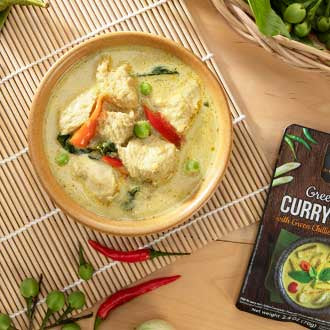
Due to its strong flavor, Thai curry is usually eaten with rice. Steamed Jasmine rice is commonly served in Central and Southern Thailand, while sticky rice is more common in Northern Thailand.
The restaurants generally serve curry in a bowl and a separate dish for rice, so the rice does not get soggy while it is waiting to be served. Thai people use a spoon and fork to eat curry, unless it is a noodle with curry soup like Khao Soi in which case chopsticks are used. Add a small amount of curry (meat and vegetables) on top of the rice, mix well into the rice and scoop the rice and curry with small and perfect bites.
You can eat all the herbs and vegetables in the curry, but some people may leave red chili peppers and Turkey berries because of its bitter taste. Sometime, curry is eaten with Roti or fried flatbread and noodles. Eating curry with Roti is similar to eat with rice. Noodles with curry can be eaten with spoon and fork or chopsticks.
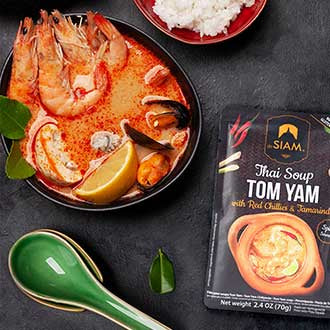
Tom Yam and Tom Kha soup are generally eaten with rice and the way of eating is similar to curry.
However, some ingredients in Tom Yam and Tom Kha such as lemongrass, galangal and kaffir lime leaves are traditionally left in the soup as garnish and not meant to be eaten since they are very tough and most of the time used in large pieces. They can be hazardous or unpleasant to eat.
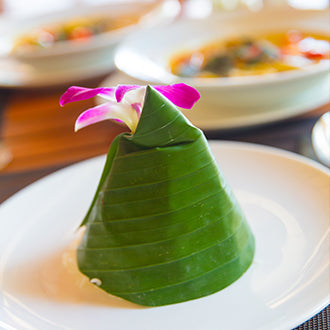
Sometimes you may find Thai food cooked or wrapped with banana, pandanus or lemon grass leaves like Hor Mok (Thai Fish Custard), Gai Hor Takrai (Fried Chicken Wrapped in Lemon Grass Leaves) Gai Hor Bai-toey (Chicken Wrapped in Pandan Leaves) or Khao Tom Mud (Coconut Rice with Banana Filling).
And the question is “how can I eat this food? Should I unwrap the leaves or eat all of it?” Thai use the leaves as natural containers that are safe for cooking and add fragrance to the food but are not meant to be eaten.
They are hard to chew, the taste is unpleasant, and some are not edible. Unwrap or remove the leaves before you eat the food.